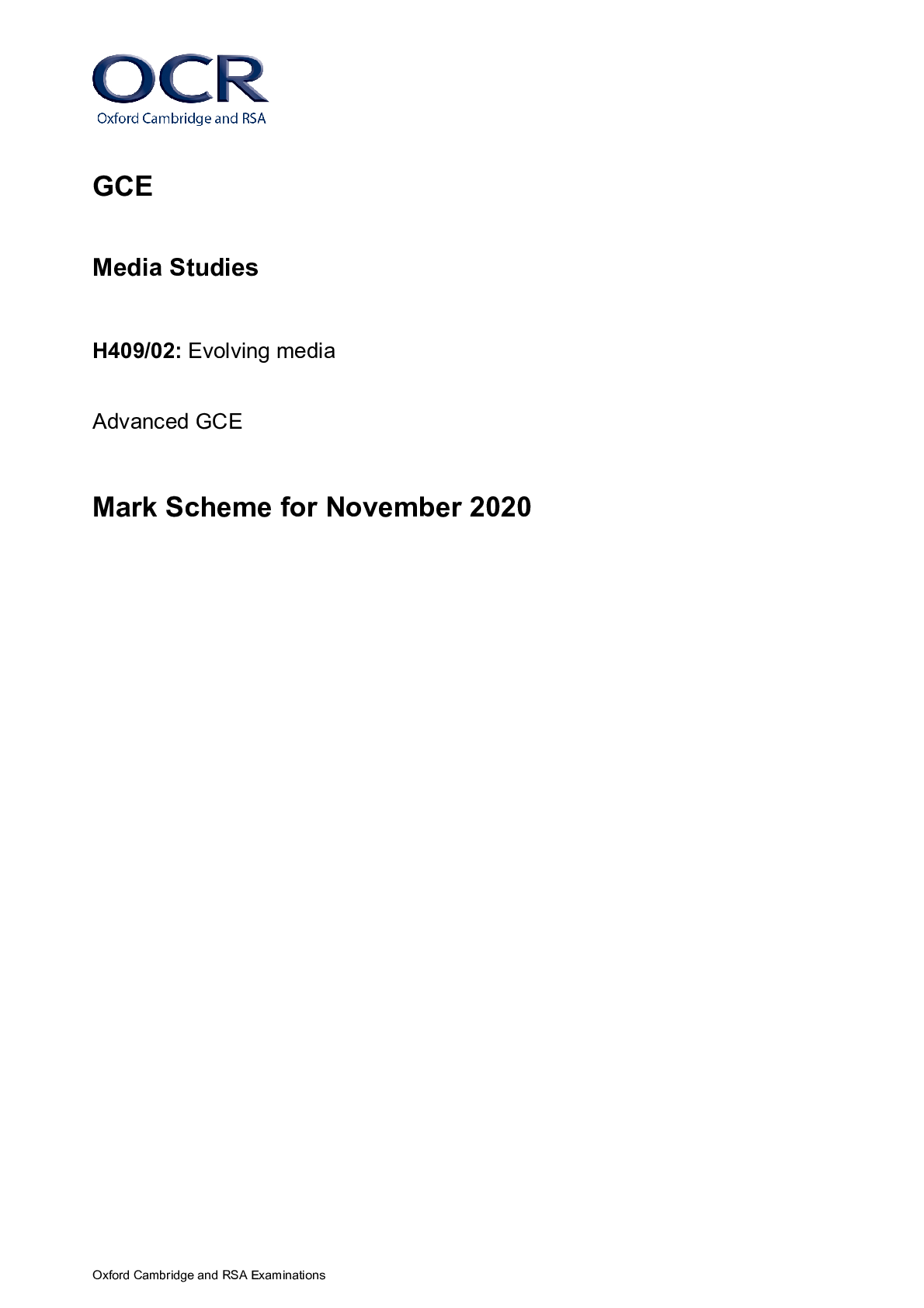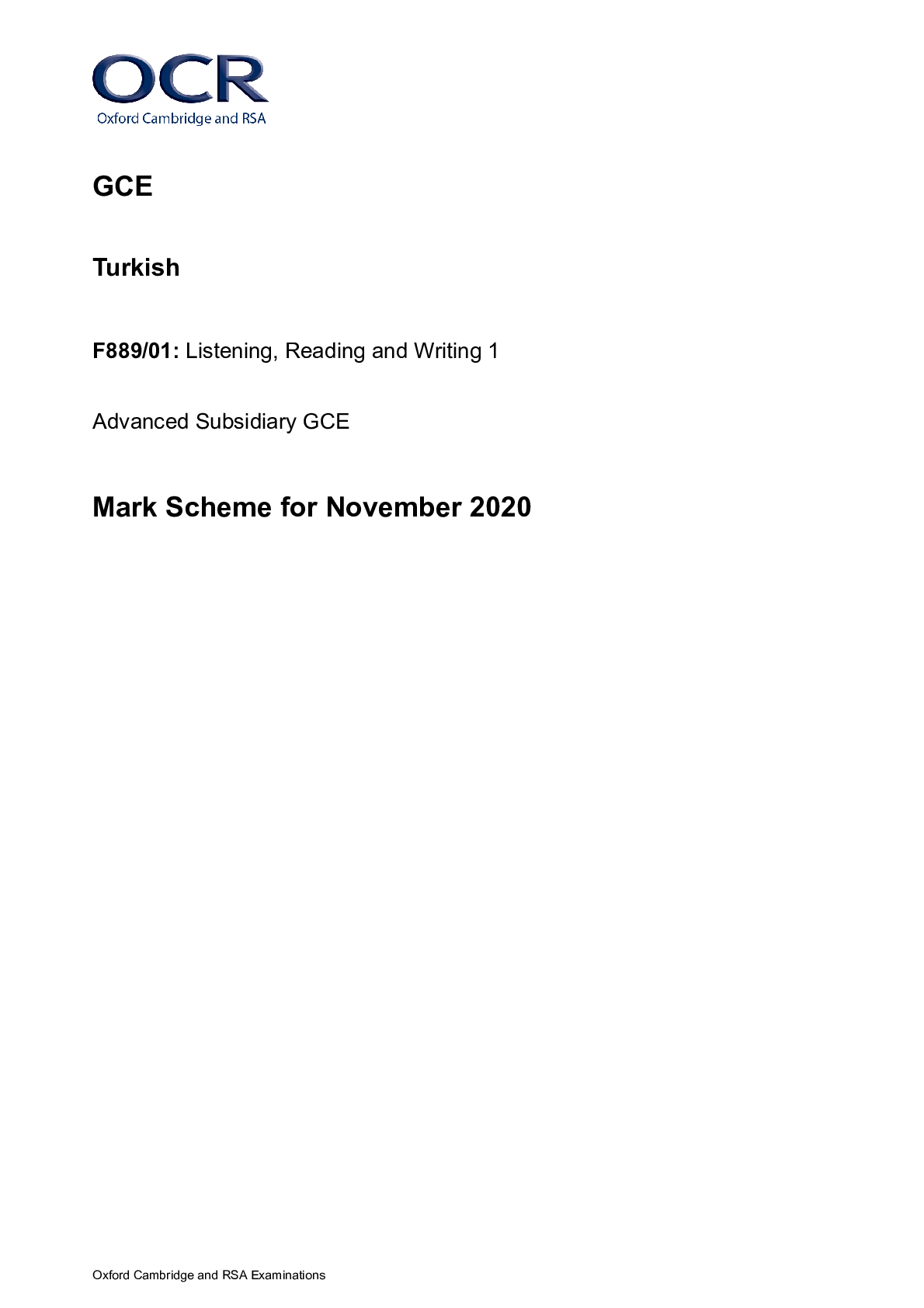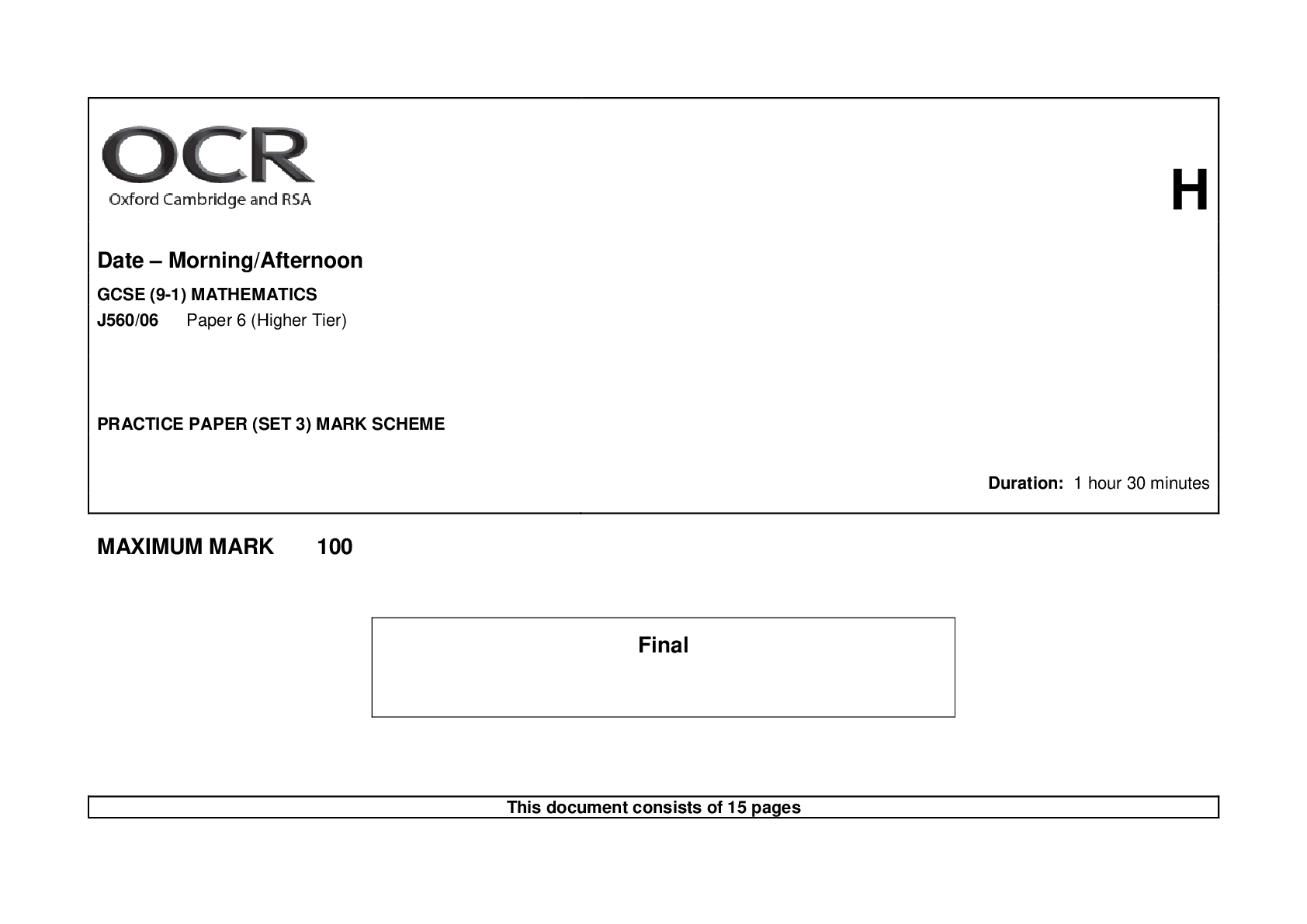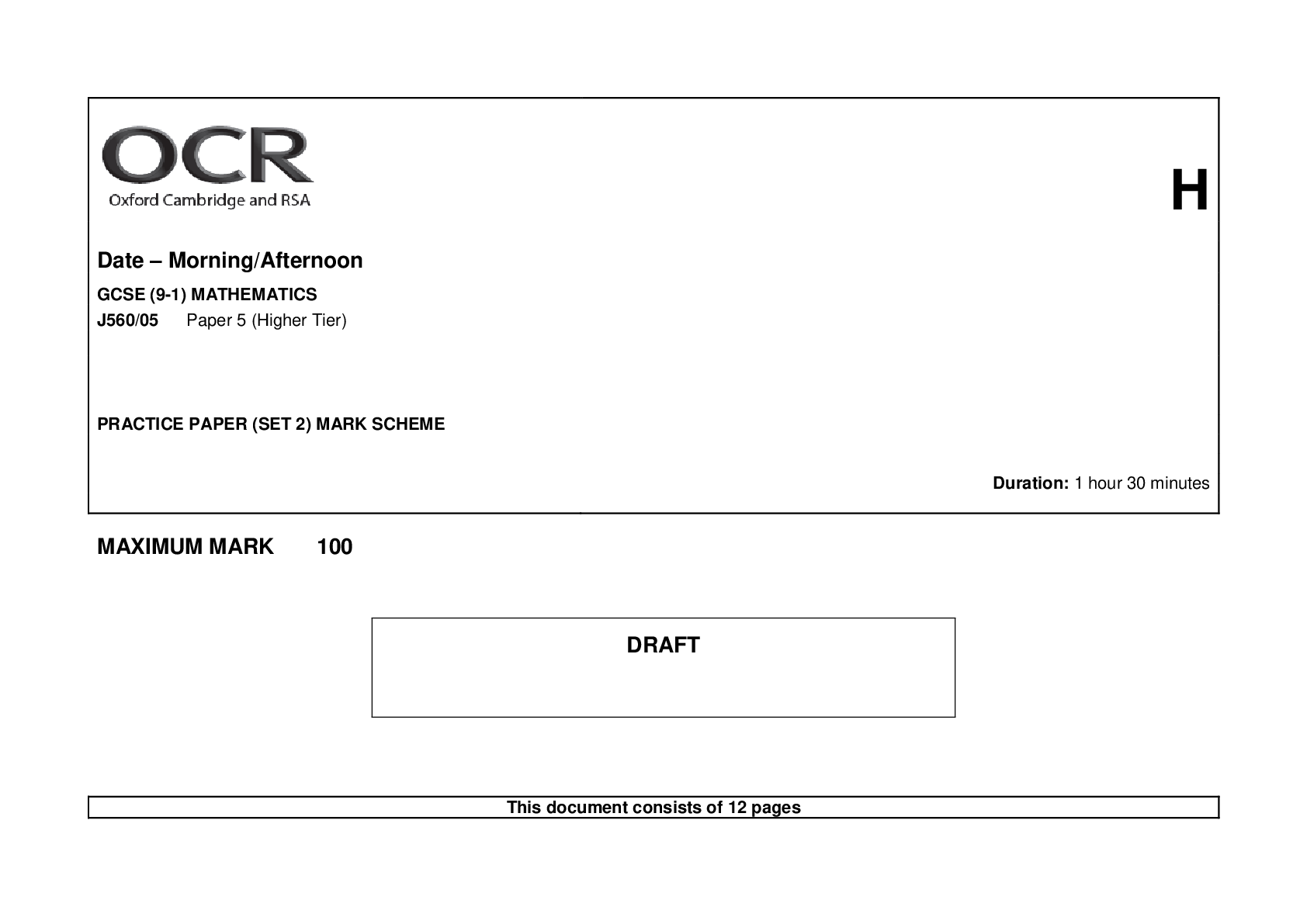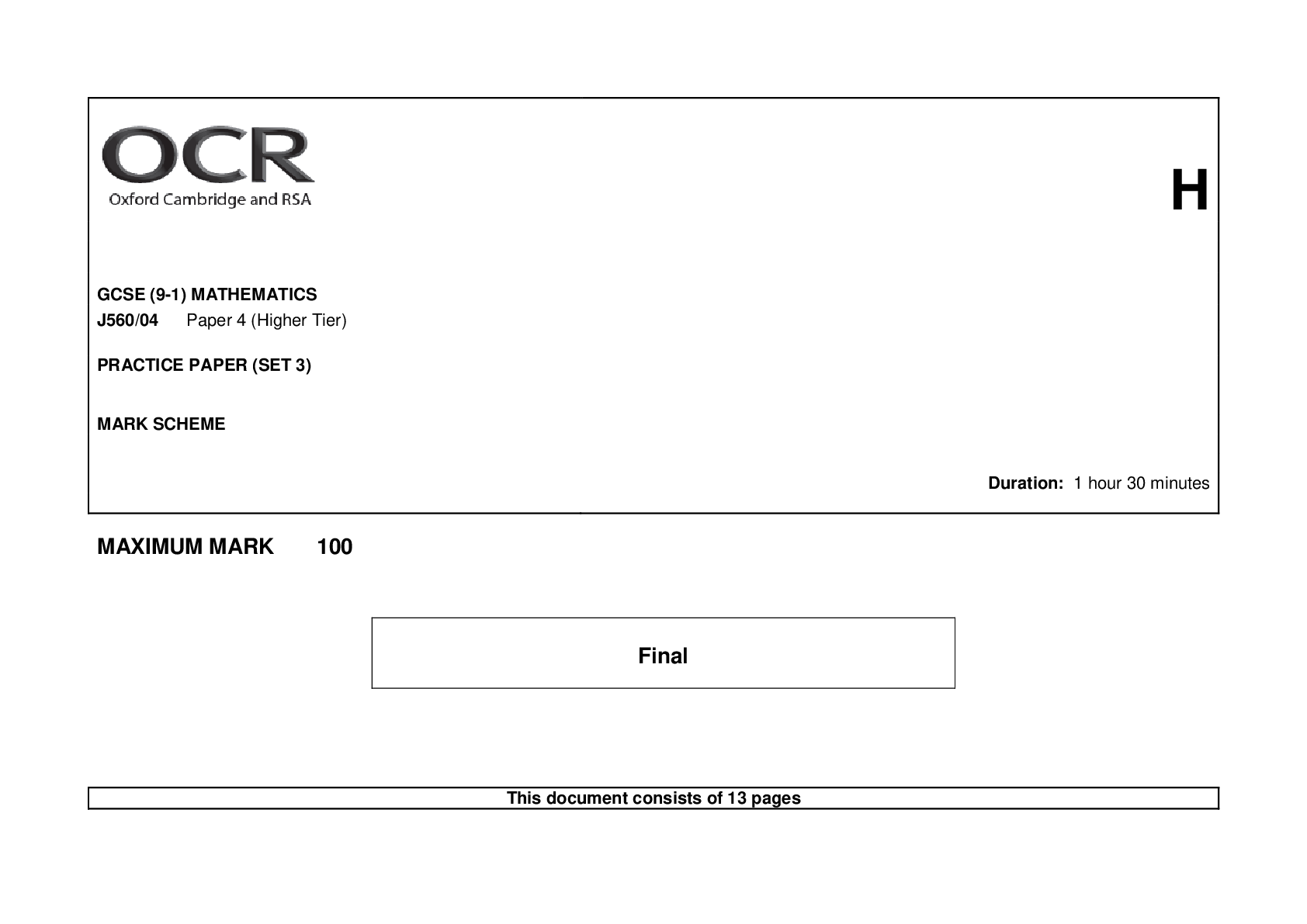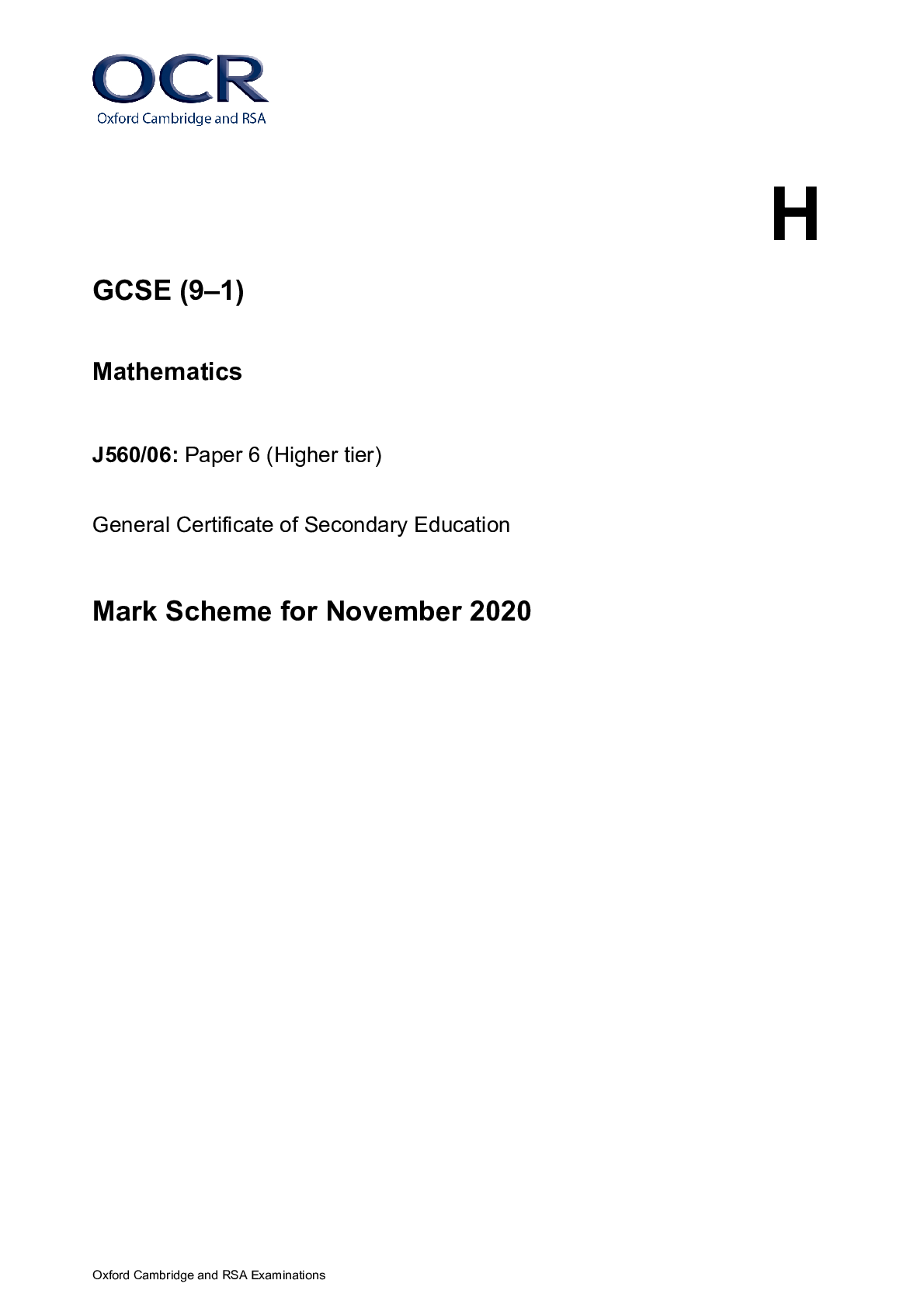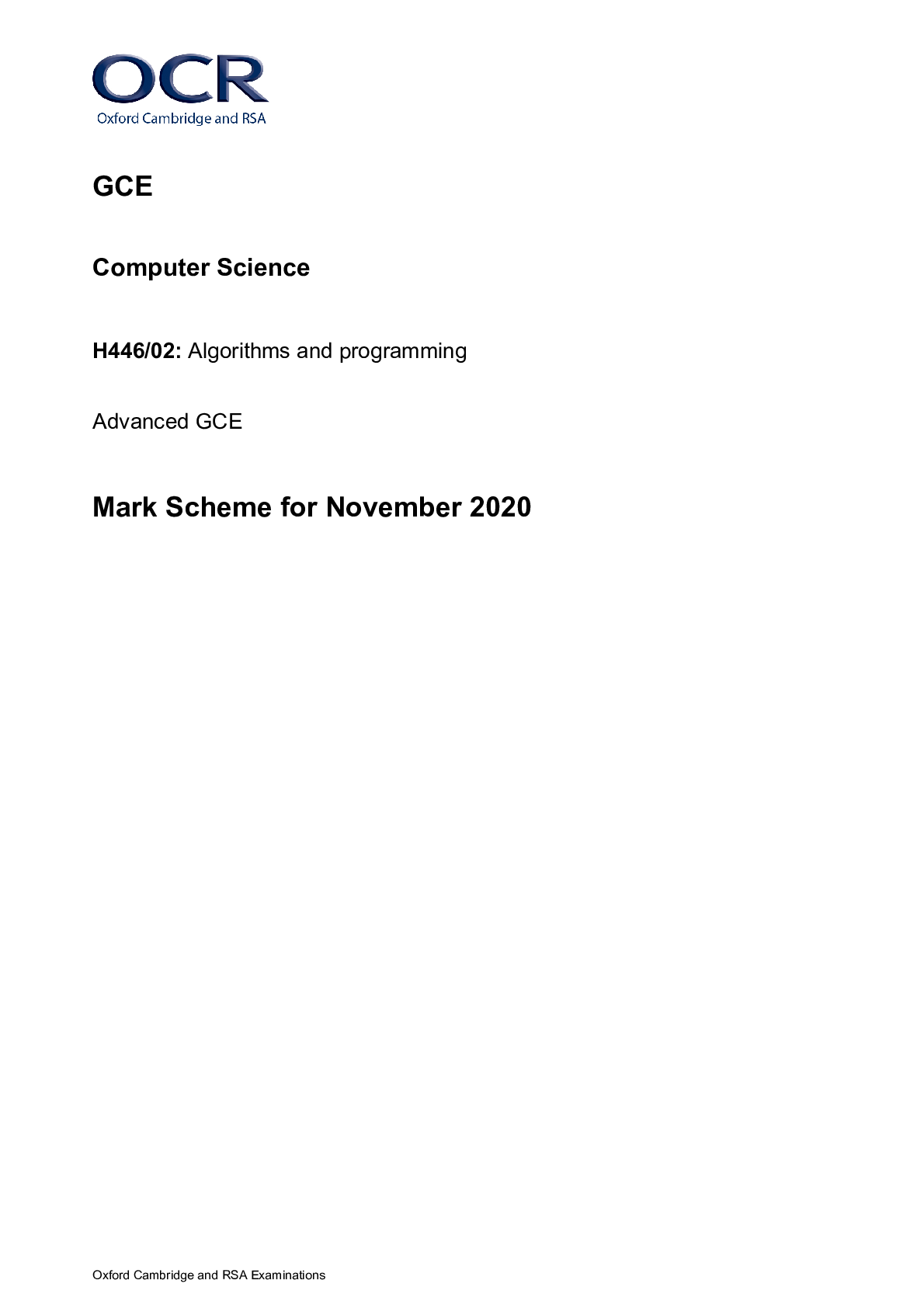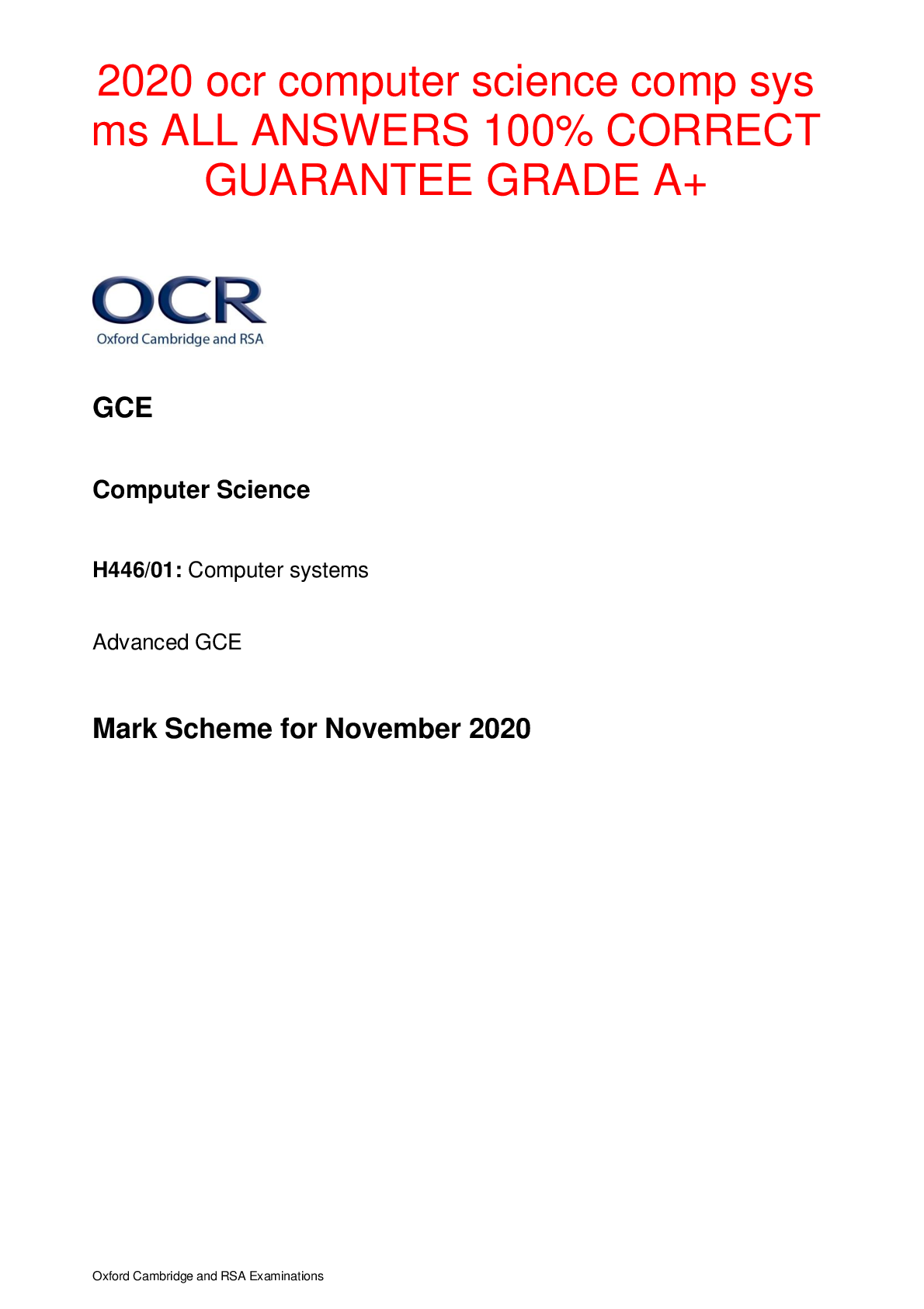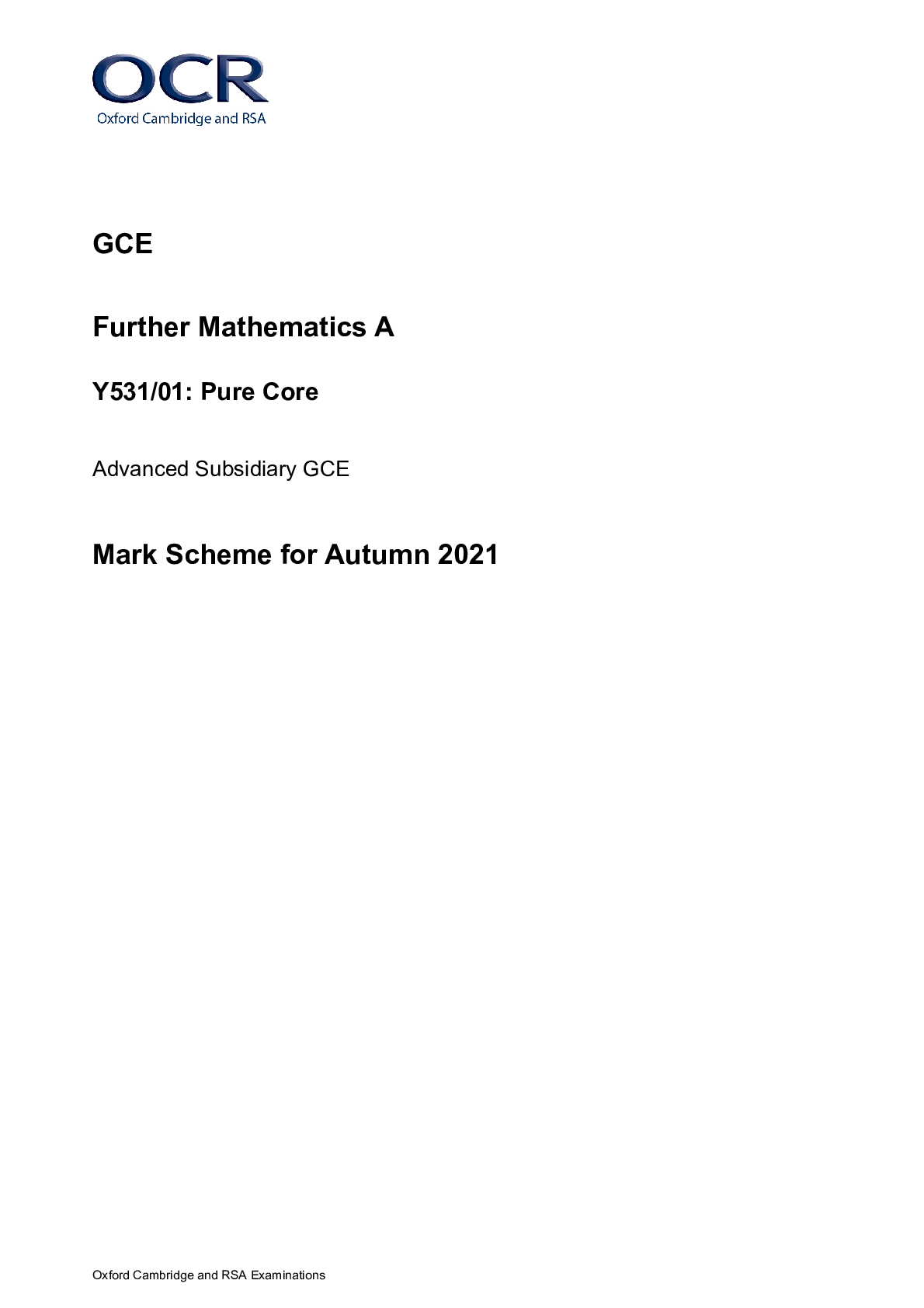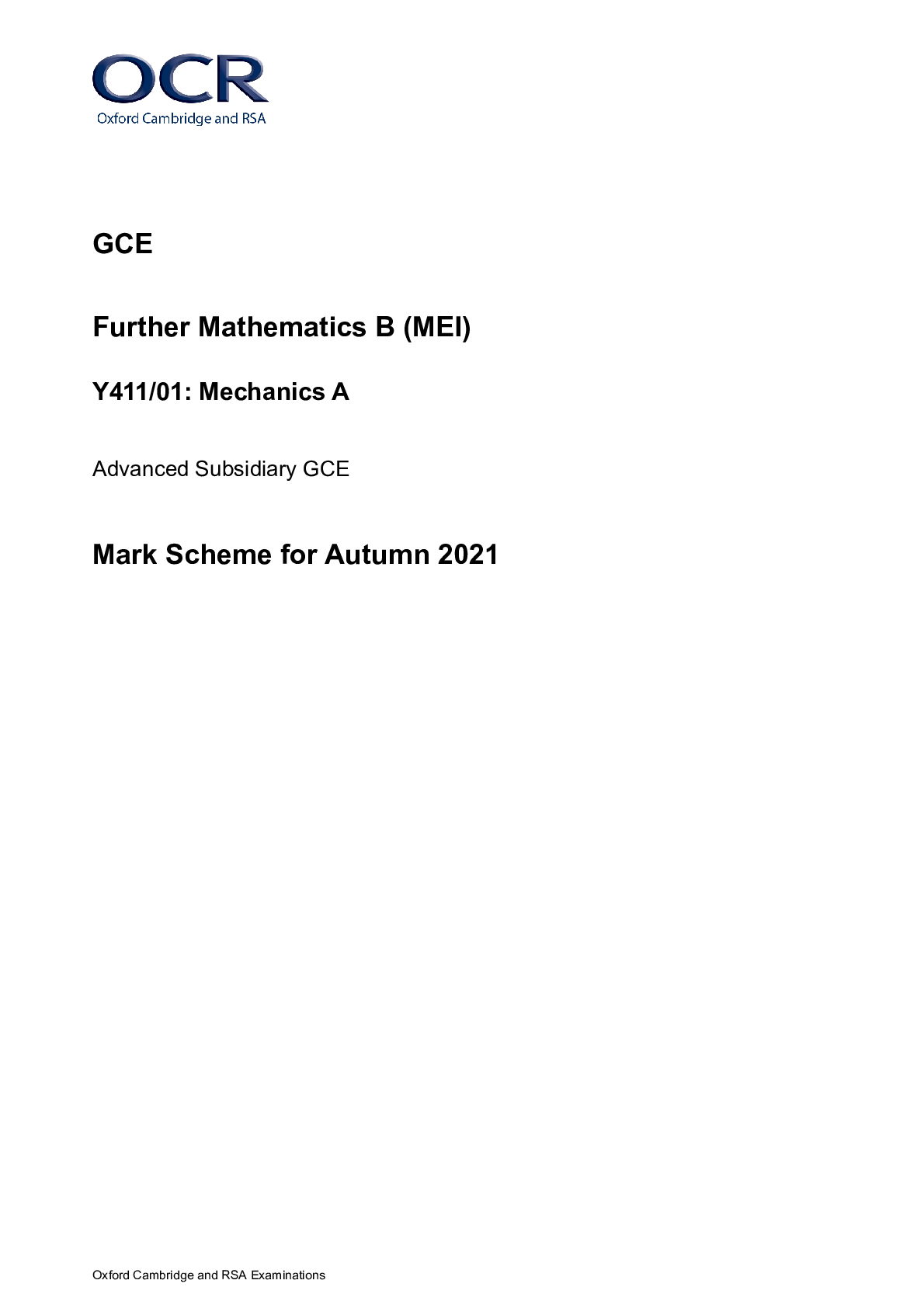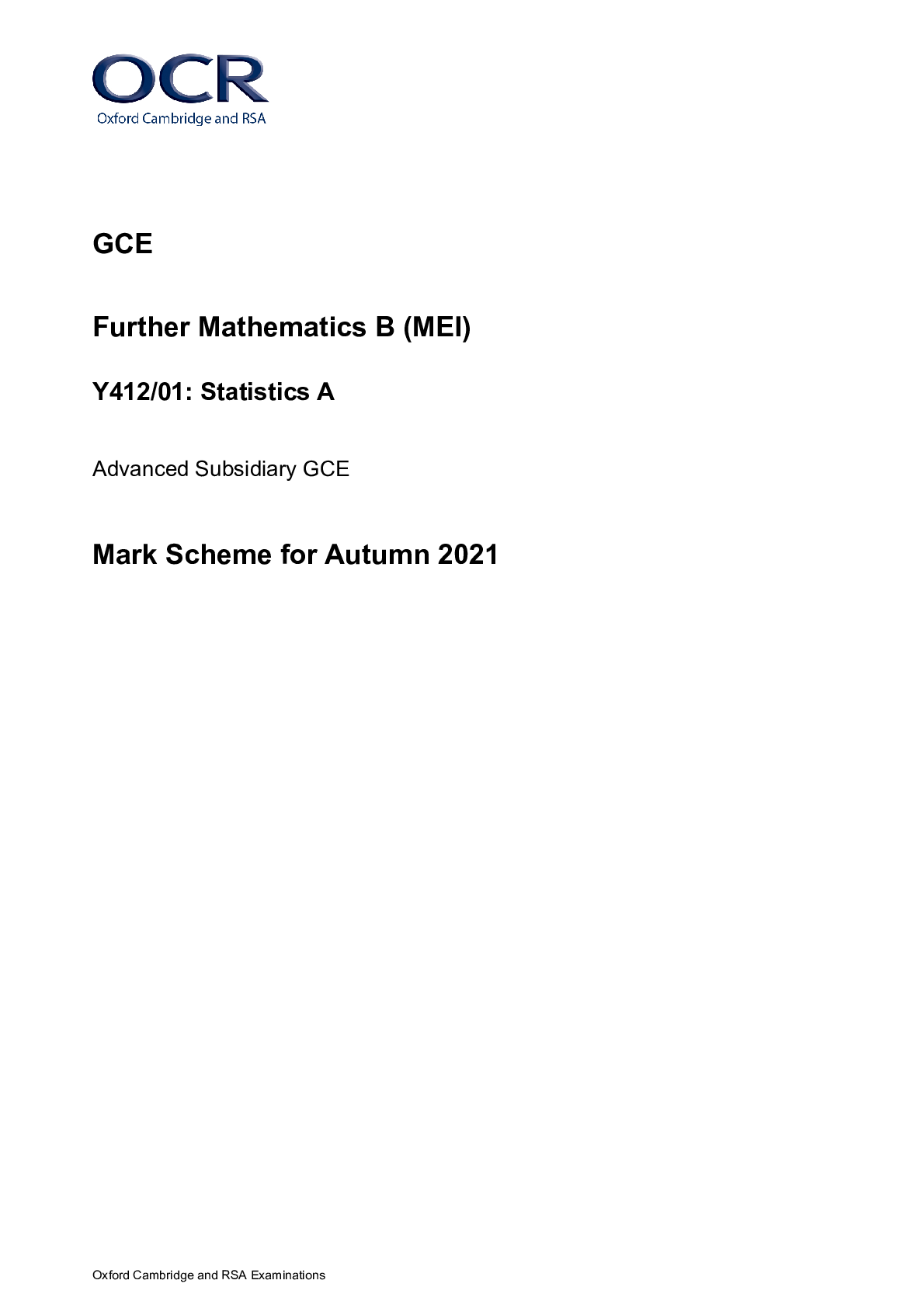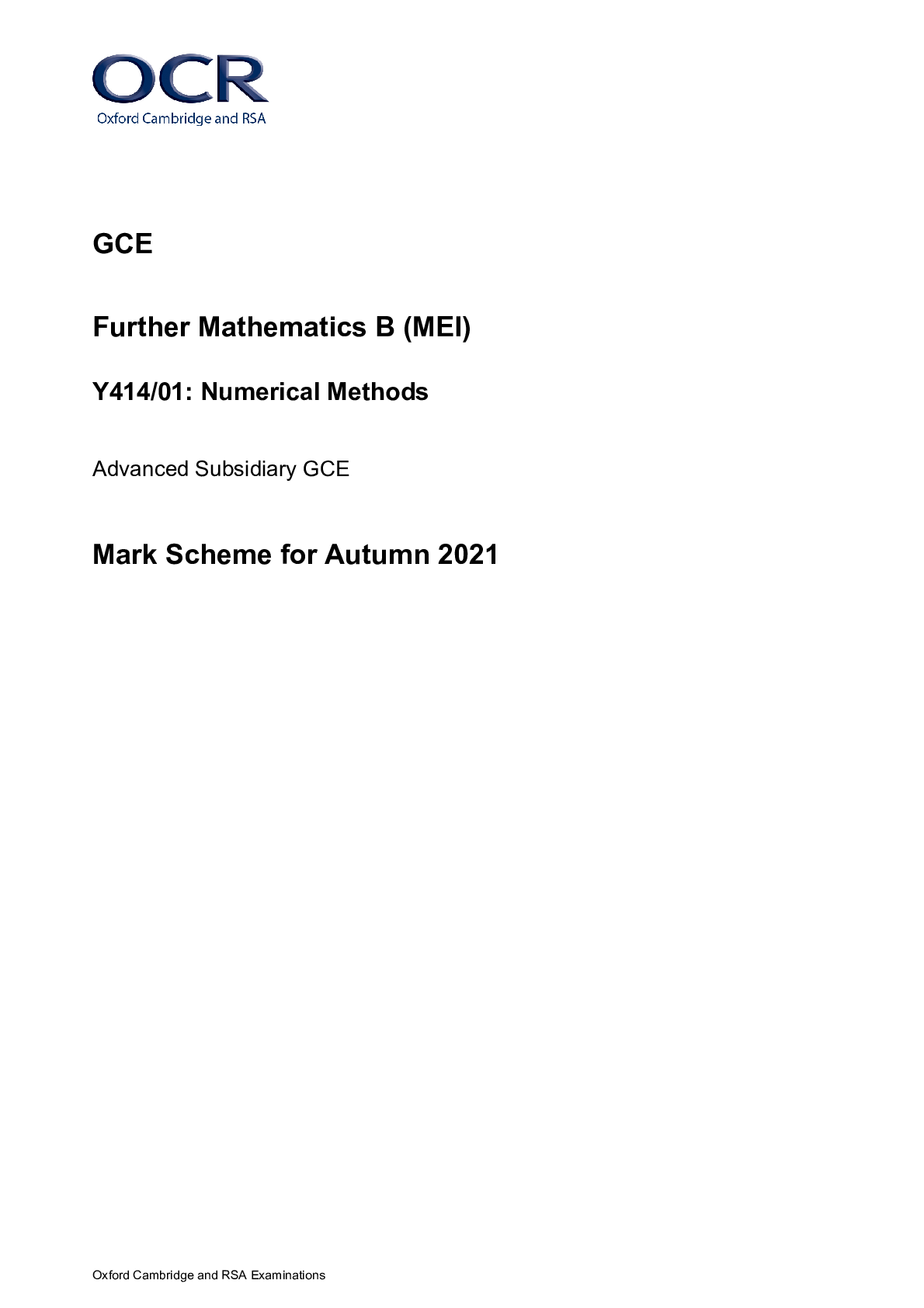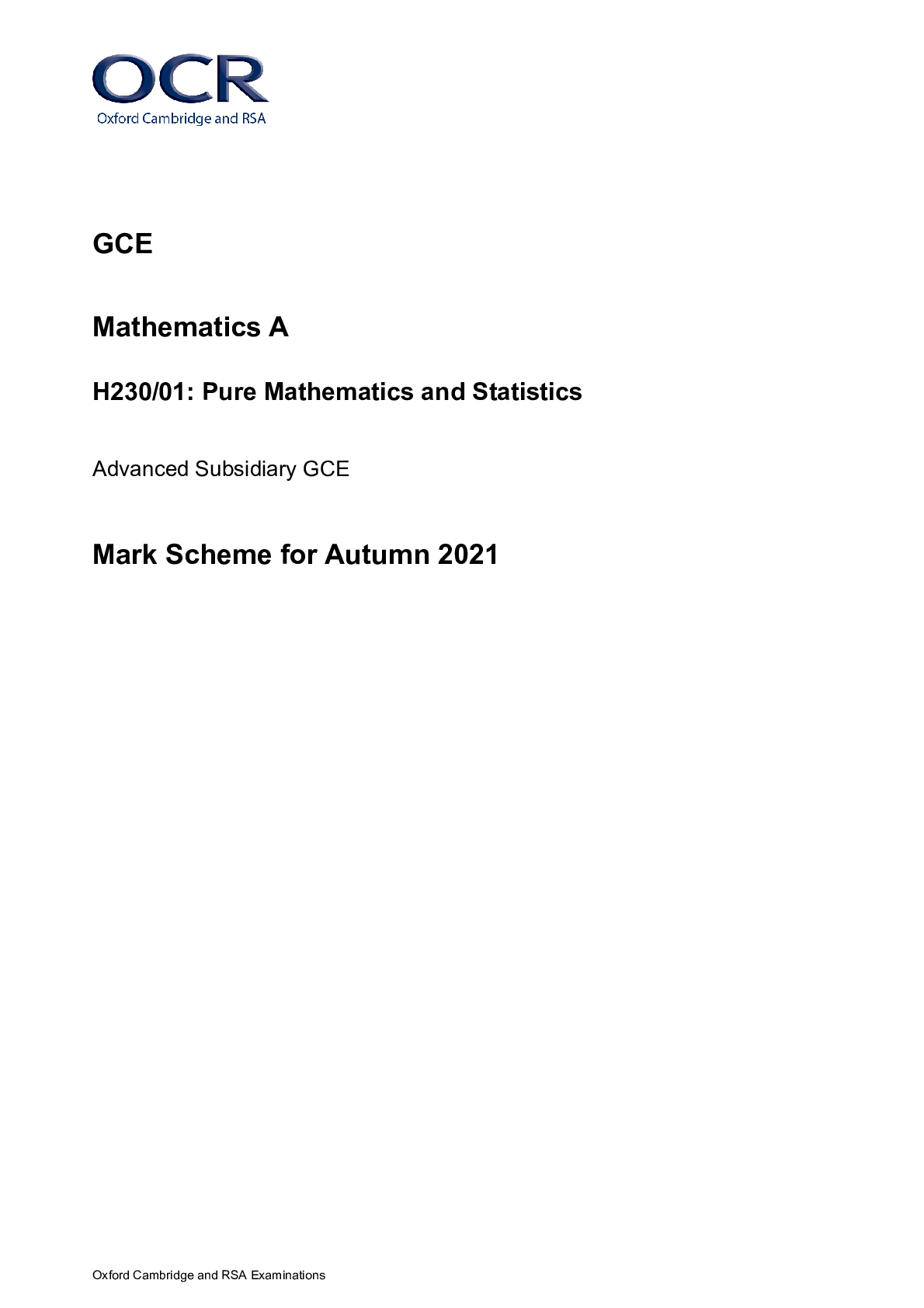History > MARK SCHEME > GCE Ancient History H007/01: Relations between Greek states and between Greek and nonGreek states 49 (All)
GCE Ancient History H007/01: Relations between Greek states and between Greek and nonGreek states 492-404 BC Advanced Subsidiary GCE Mark Scheme for November 2020
Document Content and Description Below
GCE Ancient History H007/01: Relations between Greek states and between Greek and nonGreek states 492-404 BC Advanced Subsidiary GCE Mark Scheme for November 2020 Oxford Cambridge and RSA Exami... nations GCE Ancient History H007/01: Relations between Greek states and between Greek and nonGreek states 492-404 BC Advanced Subsidiary GCE Mark Scheme for November 2020Oxford Cambridge and RSA Examinations OCR (Oxford Cambridge and RSA) is a leading UK awarding body, providing a wide range of qualifications to meet the needs of candidates of all ages and abilities. OCR qualifications include AS/A Levels, Diplomas, GCSEs, Cambridge Nationals, Cambridge Technicals, Functional Skills, Key Skills, Entry Level qualifications, NVQs and vocational qualifications in areas such as IT, business, languages, teaching/training, administration and secretarial skills. It is also responsible for developing new specifications to meet national requirements and the needs of students and teachers. OCR is a not-for-profit organisation; any surplus made is invested back into the establishment to help towards the development of qualifications and support, which keep pace with the changing needs of today’s society. This mark scheme is published as an aid to teachers and students, to indicate the requirements of the examination. It shows the basis on which marks were awarded by examiners. It does not indicate the details of the discussions which took place at an examiners’ meeting before marking commenced. All examiners are instructed that alternative correct answers and unexpected approaches in candidates’ scripts must be given marks that fairly reflect the relevant knowledge and skills demonstrated. Mark schemes should be read in conjunction with the published question papers and the report on the examination. © OCR 2020H007/01 Mark Scheme November 2020 1. Annotations Annotation Meaning Blank Page Highlight/factualerror Evaluation KnowledgeandUnderstanding Omission Context Noted but no credit given/ irrelevant AO1 AO2 AO3H007/01 Mark Scheme November 2020 2. Subject Specific Marking Instructions Question 1 To what extent did the relationship between Athens and Sparta change in the period 479-446 BC? [10 marks] Assessment Objectives AO1 = 5 marks = Demonstrate knowledge and understanding of the key features and characteristics of the historical periods studied. AO2 = 5 marks = Analyse and evaluate historical events and historical periods to arrive at substantiated judgements Additional guidance The ‘Indicative content’ is an example of historically valid content; any other historically valid content is acceptable and should be credited in line with the levels of response. Level Marks Level descriptor Indicative content Level 5 9–10 The response demonstrates a good range of accurate and detailed knowledge and a well-developed understanding of historical features and characteristics that are fully relevant to the question. (AO1) The response has a very good explanation that convincingly and thoroughly analyses and appraises historical events and periods in order to No set answer is expected. It is possible to reach the highest marks with a conclusion either agreeing, disagreeing, or anywhere between providing the response has addressed the issue of extent. Responses should be marked in-line with the level descriptors.H007/01 Mark Scheme November 2020 Level 4 7–8 The response demonstrates a reasonable range of accurate and sometimes detailed knowledge and a reasonable understanding of historical features and characteristics that are relevant to the question. (AO1) The response has a good explanation that convincingly analyses and appraises historical events and periods in order to reach supported judgements about the historical issue in the question, though these are not consistently developed. (AO2) Candidates may discuss the following information on the relationship between Sparta and Athens in the period 479-446 BC: • The relationship in the 470s – the disgrace of Pausanias (Thucydides 1.94-5, Plutarch Aristeides 23), the Spartan decision not to try to recover the leadership of the Greeks (Diodorus 11.50). • Spartan promise to help Thasos revolt in 465 BC (Thucydides 1.101). • Spartan request for Athenian assistance after the earthquake and Helot revolt (Thucydides 1.101-103). • Athenian settlement of Messenians at Naupactus, revolt of Megara from Spartan alliance and their transfer to Athenian alliance (Thucydides 1.103). Level 3 5–6 The response demonstrates a limited range of accurate knowledge and understanding of relevant historical features and characteristics, though this may lack detail. (AO1) The response has an explanation that analyses and appraises historical events and periods, and this is linked appropriately to judgements made about the historical issue in the question, though the way in which the analysis supports the judgements may not always be made fully explicit. (AO2) • Athenian operations against Peloponnesian allies in the 450s and the battle of Tanagra (Thucydides 1.107- 8). • The five-year truce between Athens and Sparta of 451 BC (Thucydides 1.112). • Spartan invasion of Attica under King Pleistoanax in 446 BC (Thucydides 1.114, Plutarch Pericles 23.1-2). Level 3 3–4 The response demonstrates some limited knowledge and understanding of relevant historical features and characteristics, though lacking detail and in places inaccurate. (AO1) The response has some explanation which analyses and appraises historical events and periods in places, and this is linked appropriately to some of the judgements made about the historical issue in the question, though the way in which the judgements are supported is not made explicit. (AO2)H007/01 Mark Scheme November 2020 Level 1 1–2 The response demonstrates only very limited and generalised knowledge and understanding of any relevant historical features and characteristics. (AO1) The response has a basic explanation with limited analysis and appraisal of historical events and periods relating to the historical issue in the question. If judgements are made, these are not adequately linked to the explanation and are close to assertions. (AO2) 0 No response or no response worthy of creditH007/01 Mark Scheme November 2020 Question 2 On the basis of this passage, and other sources you have studied, to what extent was Pericles responsible for the outbreak of the Peloponnesian War in 431 BC? [20 marks] Assessment Objectives AO1 = 5 marks = Demonstrate knowledge and understanding of the key features and characteristics of the historical periods studied. AO3 = 15 marks = Use, analyse and evaluate ancient sources within their historical context to make judgements and reach conclusions about: • historical events and historical periods studied • how the portrayal of events by ancient writers/sources relates to the historical contexts in which they were written/produced. Additional guidance The ‘Indicative content’ is an example of historically valid content; any other historically valid content is acceptable and should be credited in line with the levels of response. Level Marks Level descriptor Indicative content Level 5 17–20 Response uses a good range of appropriate examples from the set source(s) and other ancient sources. The sources are analysed and evaluated, to reach logically reasoned, developed judgements about how the way they portray events relates to the context in which they were produced, and to draw substantiated and convincing conclusions about the historical issue in the question. (AO3) The response demonstrates a good range of accurate and detailed knowledge and a well-developed understanding of historical features and characteristics that are fully relevant to the question. (AO1) No set answer is expected. It is possible to reach the highest marks with a conclusion agreeing, disagreeing or anywhere between providing the response has addressed the issue of extent. Responses should be marked in-line with the level descriptors. For the top level, candidates need to use the source material to come to a judgement and conclusion regarding the extent to which Pericles and the Megarian Decree were responsible for the outbreak of the Peloponnesian War in 431 BC. Information from the passage, Aristophanes Akharnians 524- 539: • the idea that the Megarian Decree was over something fairly trivial • it caused the Megarians to appeal to SpartaH007/01 Mark Scheme November 2020 Level 4 13–16 Response uses a range of appropriate examples from set source(s) and other ancient sources. The sources are analysed and evaluated, to reach logically reasoned judgements about how the way they portray events relates to the context in which they were produced, and to draw supported, plausible conclusions about the historical issue in the question. (AO3) The response demonstrates a reasonable range of accurate and sometimes detailed knowledge and a reasonable understanding of historical features and characteristics that are relevant to the question.(AO1) • Pericles was in some way responsible for the Decree • The Spartans asked the Athenians to repeal the Decree, but Athens refused Other sources referred to might include: • The Megarians complained to Sparta and outlined the nature of their complaint (Thucydides 1.67.1-4) • Spartan demand that Athenians repeal the Decree to avoid war and Athenian refusal; nature of Athenian complaints against Megara (Thucydides 1.139.1-2) • Pericles was certainly believed to be responsible both for the decree and opposing its repeal (Plutarch Pericles 30-31); Pericles’ speech in response to the Spartan demand (Thucydides 1. 140) • Candidates might also refer to other causes of complaint against the Athenians as outlined by Thucydides such as the Corcyra and Potidaea affairs • Reference might also be made to Thucydides’ analysis of the real reason for the war – Spartan fear of Athens’ growing power (Thucydides 1.23), and the belief in Athens that war was bound to come (1.44), and the grievances of either side outlined in 1.66. Level 3 9–12 Response uses some appropriate examples from the set source(s) and other ancient sources. The sources are analysed and evaluated, to reach judgements about how the way they portray events relates to the context in which they were produced, and to draw some supported conclusions about the historical issue in the question. (AO3) The response demonstrates a limited range of accurate knowledge and understanding of relevant historical features and characteristics, though this may lack detail. (AO1) Level 2 5–8 Response uses a limited selection of appropriate examples from the set source(s) and other ancient sources. The sources are analysed and evaluated in a basic way, and this is linked to basic, generalised judgements about how the way they portray events relates to the context in which they were produced. There are some basic conclusions about the historical issue in the question, though these may only be implicitly linked with the analysis and evaluation of the sources. (AO3) The response demonstrates some limited knowledge and understanding of relevant historical features and characteristics, though lacking detail and in places inaccurate. (AO1)H007/01 Mark Scheme November 2020 Level 1 1–4 Response uses only a very limited selection of appropriate examples from the set source(s) and/or ancient sources with a basic attempt to analyse and evaluate these. There are few, very basic and stock attempts at judgement about how the way the sources portray events relates to the context in which they were produced. There are few very basic conclusions about the historical issue in the question, which will be only implicitly linked to analysis at best and may be closer to assertion. (AO3) The response demonstrates only very limited and generalised knowledge and understanding of any relevant historical features and characteristics. (AO1) 0 No response or no response worthy of creditH007/01 Mark Scheme November 2020 Question 3* ‘Their superior leadership enabled the Greeks to defeat the Persians in the period 490-479 BC.’ To what extent do you agree with this view? [30 marks] Assessment Objectives AO1 = 5 marks = Demonstrate knowledge and understanding of the key features and characteristics of the historical periods studied. AO2 = 10 marks = Analyse and evaluate historical events and historical periods to arrive at substantiated judgements AO3 = 15 marks = Use, analyse and evaluate ancient sources within their historical context to make judgements and reach conclusions about: • historical events and historical periods studied • how the portrayal of events by ancient writers/sources relates to the historical contexts in which they were written/produced. Additional guidance The ‘Indicative content’ is an example of historically valid content; any other historically valid content is acceptable and should be credited in line with the levels of response. Level Marks Leveldescriptor Indicativecontent Level 5 25–30 Response uses a good range of appropriate examples from the ancient sources. The sources are analysed and evaluated, to reach logically reasoned, developed judgements about how the way they portray events relates to the context in which they were produced, and to draw substantiated and convincing conclusions about the historical issue in the question. (AO3) The response has a very good explanation that convincingly and thoroughly analyses and appraises historical events and periods in order to reach substantiated and developed judgements. (AO2) The response demonstrates a good range of accurate and detailed knowledge and a well‐developed understanding of relevant historical features and characteristics. There is a consistent focus on the question throughout the answer. (AO1) There is a well‐developed and sustained line of reasoning which is coherent and logically structured. The information presented is entirely relevant and substantiated. No set answer is expected. It is possible to reach the highest marks with conclusion(s) either agreeing, disagreeing, or anywhere between providing the response has addressed the issue of extent. Responses should be marked in-line with the level descriptors. Candidates should question the idea of Greek ‘superior leadership’ and look at the extent to which the sources support the view suggested. They may well consider the leadership of the Greeks but may also discuss that of the Persians. Candidates will be expected to cover all the conflicts in the given time period in the question. Candidates should also consider other factors which might have led to the Greeks’ victory in order to address ‘extent’. Candidates may look at: • Persian preparations before 490, request for earth & water and reactions of Athens & Sparta (Herodotus 7.133) • the leadership of the Athenians in the Marathon campaign of 490, including the command structure and meeting to discuss command on the day of the battle • the tactics employed by the Athenians in the battle of Marathon • the inter-war years, including Darius’ reaction and succession of Xerxes, the Athenian change to election of generals (487), ostracisms and Themistocles’ persuasion of the Athenians to use the Laurium silver for ships and interpretation of Delphic oracle Level 4 19–24 Response uses a range of appropriate examples from the ancient sources. The sources are analysed and evaluated, to reach logically reasoned judgements about how the way they portray events relates to the context in which they were produced, and to draw supported, plausible conclusions about the historical issue in the question. (AO3)H007/01 Mark Scheme November 2020 The response has a good explanation that convincingly analyses and appraises historical events and periods in order to reach supported judgements, though these are not consistently developed. (AO2) The response demonstrates a reasonable range of accurate and sometimes detailed knowledge and a reasonable understanding of relevant historical features and characteristics. There is a consistent focus on the question through most of the answer. (AO1) There is a well‐developed line of reasoning which is clear and logically structured. The information presented is relevant and substantiated. • the congresses and preparations of the Greeks and discussions concerning overall leadership • the discussions of the Greeks over strategy, Tempe, and the roles of Leonidas and Themistocles in deciding strategy and tactics at Thermopylae and Artemisium • Lack of agreement amongst the Greeks between Thermopylae and Salamis and Themistocles’ role in managing to have the battle at Salamis; the tactics used by the Greeks at Salamis • Lack of agreement amongst the Greeks about what to do after Salamis • Reluctance of Peloponnesians to commit to defending Attica in 479 • Greek tactics at the battle of Plataea and the role of Pausanias • A comparison of Greek and Persian equipment, including triremes • The leadership of the Persians, including the role and character of Xerxes as portrayed by Herodotus • The importance of Greek geography • The unity, or otherwise, of the Greeks Supporting source details may include: • Herodotus: 6.48-9 (Persian preparations), 103-116 (Athenian preparations and the battle of Marathon); • Herodotus 7.1 (Darius’ reaction), 7.49-50 (Artabanus’ warning re the geography and size of the Persian force), 133, 139 (Herodotus’ opinion about the importance of the Athenians), 141-5 (Themistocles & Delphic oracle and Greek conference), 175 (decision to defend Thermopylae), 207 (doubt amongst the Greeks at Thermopylae) • Herodotus 8.3 (discussions over leadership of Greek fleet), 49-50 (council of war before Salamis), 56-63 (threat to retreat to Isthmus of Corinth and Themistocles’ role in securing the battle at Salamis) • Herodotus 9.6-8 (preference of Peloponnesians to defend Isthmus wall & Athenian request to defend Attica), 62 (comparison of Persian and Spartan troops), 71 (contribution of Spartans) • The Serpent column (the extent of the Greek alliance) Level 3 13–18 Response uses some appropriate examples from the ancient sources. The sources are analysed and evaluated, to reach judgements about how the way they portray events relates to the context in which they were produced, and to draw some supported conclusions about the historical issue in the question. (AO3) The response has an explanation that analyses and appraises historical events and periods, and this is linked appropriately to judgements made, though the way in which it supports the judgements may not always be made fully explicit. (AO2) The response demonstrates a limited range of accurate knowledge and understanding of relevant historical features and characteristics, though this may lack detail. The question is generally addressed, but the response loses focus in places. (AO1) There is a line of reasoning presented with some structure. The information presented is in the most‐part relevant and supported by some evidence. Level 2 7–12 Response uses a limited selection of appropriate examples from the ancient sources. The sources are analysed and evaluated in a basic way, and this is linked to basic, generalised judgements about how the way they portray events relates to the context in which they were produced.H007/01 Mark Scheme November 2020 There are some basic conclusions about the historical issue in the question, though these may only be implicitly linked with the analysis and evaluation of the sources. (AO3) The response has some explanation which analyses and appraises historical events and periods in places, and this is linked appropriately to some of the judgements made, though the way in which it supports the judgements is not made explicit. (AO2) The response demonstrates some limited knowledge and understanding of relevant historical features and characteristics, though lacking detail and in places inaccurate. The question is only partially addressed. (AO1) The information has some relevance and is presented with limited structure. The information is supported by limited evidence. Credit all relevant sources Analysis of the sources might focus on: • the methodology, agendas and contexts of the Greek and Persian sources and how these affect the value of the information. • the limitation of the evidence for Persian kings and their aims, strengths and abilities mostly from a Greek viewpoint. • the limitations of the evidence for the events and issues of the period in Herodotus • problems of evidence for internal Spartan decisions and individuals, and the lack of Spartan material. Level 1 1–6 Response uses only a very limited selection of appropriate examples from the ancient sources with a basic attempt to analyse and evaluate these. There are few, very basic and stock attempts at judgement about how the way the sources portray events relates to the context in which they were produced. There are few very basic conclusions about the historical issue in the question, which will be only implicitly linked to analysis at best and may be closer to assertion. (AO3) The response has a basic explanation with limited analysis and appraisal of historical events and periods. If judgements are made, these are not adequately linked to the explanation and are close to assertions. (AO2) The response demonstrates only very limited and generalised knowledge and understanding of relevant historical features and characteristics. The focus is on the topic more than the specific demands of the question. (AO1) The information is basic and communicated in an unstructured way. The information is supported 0 No response or no response worthy of creditH007/01 Mark Scheme November 2020 Question 4* To what extent did the events at Pylos and Sphacteria in 425 BC change the course of the Peloponnesian War? [30 marks] Assessment Objectives AO1 = 5 marks = Demonstrate knowledge and understanding of the key features and characteristics of the historical periods studied. AO2 = 10 marks = Analyse and evaluate historical events and historical periods to arrive at substantiated judgements AO3 = 15 marks = Use, analyse and evaluate ancient sources within their historical context to make judgements and reach conclusions about: • historical events and historical periods studied • how the portrayal of events by ancient writers/sources relates to the historical contexts in which they were written/produced. Additional guidance The ‘Indicative content’ is an example of historically valid content; any other historically valid content is acceptable and should be credited in line with the levels of response. Level Marks Leveldescriptor Indicativecontent Level 5 25–30 Response uses a good range of appropriate examples from the ancient sources. The sources are analysed and evaluated, to reach logically reasoned, developed judgements about how the way they portray events relates to the context in which they were produced, and to draw substantiated and convincing conclusions about the historical issue in the question. (AO3) The response has a very good explanation that convincingly and thoroughly analyses and appraises historical events and periods in order to reach substantiated and developed judgements. (AO2) The response demonstrates a good range of accurate and detailed knowledge and a well‐developed understanding of relevant historical features and characteristics. There is a consistent focus on the question throughout the answer. (AO1) There is a well‐developed and sustained line of reasoning which is coherent and logically structured. The information presented is entirely relevant and substantiated. No set answer is expected. It is possible to reach the highest marks with conclusion(s) either agreeing, disagreeing, or anywhere between providing the response has addressed the issue of extent. Responses should be marked in-line with the level descriptors. Candidates should discuss the events at Pylos and Sphacteria. They should consider the immediate and long-term effects of these events on the progress of the war. Candidates may discuss the course of the war before 425 to assess ‘change’. Candidates will be expected to consider the progress of the war after 425. They may discuss events up to the Peace of Nicias (421 BC), or through to the end of the in 404 BC. Candidates may also consider other factors which might have led to the eventual Spartan victory in order to address ‘extent’. Candidates may look at: • What actually happened at Pylos and Sphacteria, including the Spartan offer of peace • The immediate effects on the Greek world • Protection the Spartan prisoners afforded Athens (mention of previous annual invasions would contribute to ‘change’) & ‘Athenian guerilla’ warfare in PeloponneseH007/01 Mark Scheme November 2020 Level 4 19–24 Response uses a range of appropriate examples from the ancient sources. The sources are analysed and evaluated, to reach logically reasoned judgements about how the way they portray events relates to the context in which they were produced, and to draw supported, plausible conclusions about the historical issue in the question. (AO3) The response has a good explanation that convincingly analyses and appraises historical events and periods in order to reach supported judgements, though these are not consistently developed. (AO2) The response demonstrates a reasonable range of accurate and sometimes detailed knowledge and a reasonable understanding of relevant historical features and characteristics. There is a consistent focus on the question through most of the answer. (AO1) There is a well‐developed line of reasoning which is clear and logically structured. The information presented is relevant and substantiated. • Early Spartan contact with Persia • Change in Spartan strategy and Brasidas sent to Thrace, capture of Amphipolis • Armistice (423) and Peace of Nicias (421); Sparta’s ignoring wishes of her allies on whose behalf she had originally gone to war • Formation of anti-Spartan alliance • The Sicilian expedition and its consequences • Alcibiades’ advice that the Spartans should fortify Decelea and its effects on Athens • Spartan agreement with Persia Supporting source details may include: • Thucydides 4.19-20 (Spartan offer of peace in 425), 40-41 (effect on Greek world and Athenian actions in the Peloponnese, 50 (Persian embassy to Sparta), 80-81, 108 (Sparta sends Brasidas to Thrace, and reasons for this; his successes), 117 (armistice) • Thucydides 5.13-18 (reasons for Peace of Nicias & its terms), 25-26 (reactions of Sparta’s allies), 43 (Alcibiades, Argos, Mantinea and Elis) • Thucydides 6.91 (advice to Spartans to fortify Decelea), 27- 28 (its effect on the Athenians) • Thucydides 8.2 (effect of Sicilian disaster on Greek public opinion), 6 (Persian overtures to Sparta), 18 (Spartan alliance with Persia), 37 (further treaty with Persia) • Xenophon 2.1.11-12 (importance of Persian money to pay Peloponnesian fleet) Credit all relevant source material Analysis of the sources might focus on: • the methodology, agendas and contexts of the sources used and how these affect the value of the information. • the limitations of the evidence for the events and issues of the period in Thucydides; his agenda and potential bias • the lack of information after 411 BC compared with earlier • problems of evidence for internal Spartan politics and individuals, and the lack of Spartan material. Level 3 13–18 Response uses some appropriate examples from the ancient sources. The sources are analysed and evaluated, to reach judgements about how the way they portray events relates to the context in which they were produced, and to draw some supported conclusions about the historical issue in the question. (AO3) The response has an explanation that analyses and appraises historical events and periods, and this is linked appropriately to judgements made, though the way in which it supports the judgements may not always be made fully explicit. (AO2) The response demonstrates a limited range of accurate knowledge and understanding of relevant historical features and characteristics, though this may lack detail. The question is generally addressed, but the response loses focus in places. (AO1) There is a line of reasoning presented with some structure. The information presented is in the most‐part relevant and supported by some evidence.H007/01 Mark Scheme November 2020 Level 2 7–12 Response uses a limited selection of appropriate examples from the ancient sources. The sources are analysed and evaluated in a basic way, and this is linked to basic, generalised judgements about how the way they portray events relates to the context in which they were produced. There are some basic conclusions about the historical issue in the question, though these may only be implicitly linked with the analysis and evaluation of the sources. (AO3) The response has some explanation which analyses and appraises historical events and periods in places, and this is linked appropriately to some of the judgements made, though the way in which it supports the judgements is not made explicit. (AO2) The response demonstrates some limited knowledge and understanding of relevant historical features and characteristics, though lacking detail and in places inaccurate. The question is only partially addressed. (AO1) The information has some relevance and is presented with limited structure. The information is supported by limited evidence. Level 1 1–6 Response uses only a very limited selection of appropriate examples from the ancient sources with a basic attempt to analyse and evaluate these. There are few, very basic and stock attempts at judgement about how the way the sources portray events relates to the context in which they were produced. There are few very basic conclusions about the historical issue in the question, which will be only implicitly linked to analysis at best and may be closer to assertion. (AO3) The response has a basic explanation with limited analysis and appraisal of historical events and periods. If judgements are made, these are not adequately linked to the explanation and are close to assertions. (AO2) The response demonstrates only very limited and generalised knowledge and understanding of relevant historical features and characteristics. The focus is on the topic more than the specific demands of the question. (AO1) The information is basic and communicated in an unstructured way. The information is supported 0 No response or no response worthy of creditOCR (Oxford Cambridge and RSA Examinations) The Triangle Building Shaftesbury Road Cambridge CB2 8EA [Show More]
Last updated: 1 year ago
Preview 1 out of 16 pages
Instant download
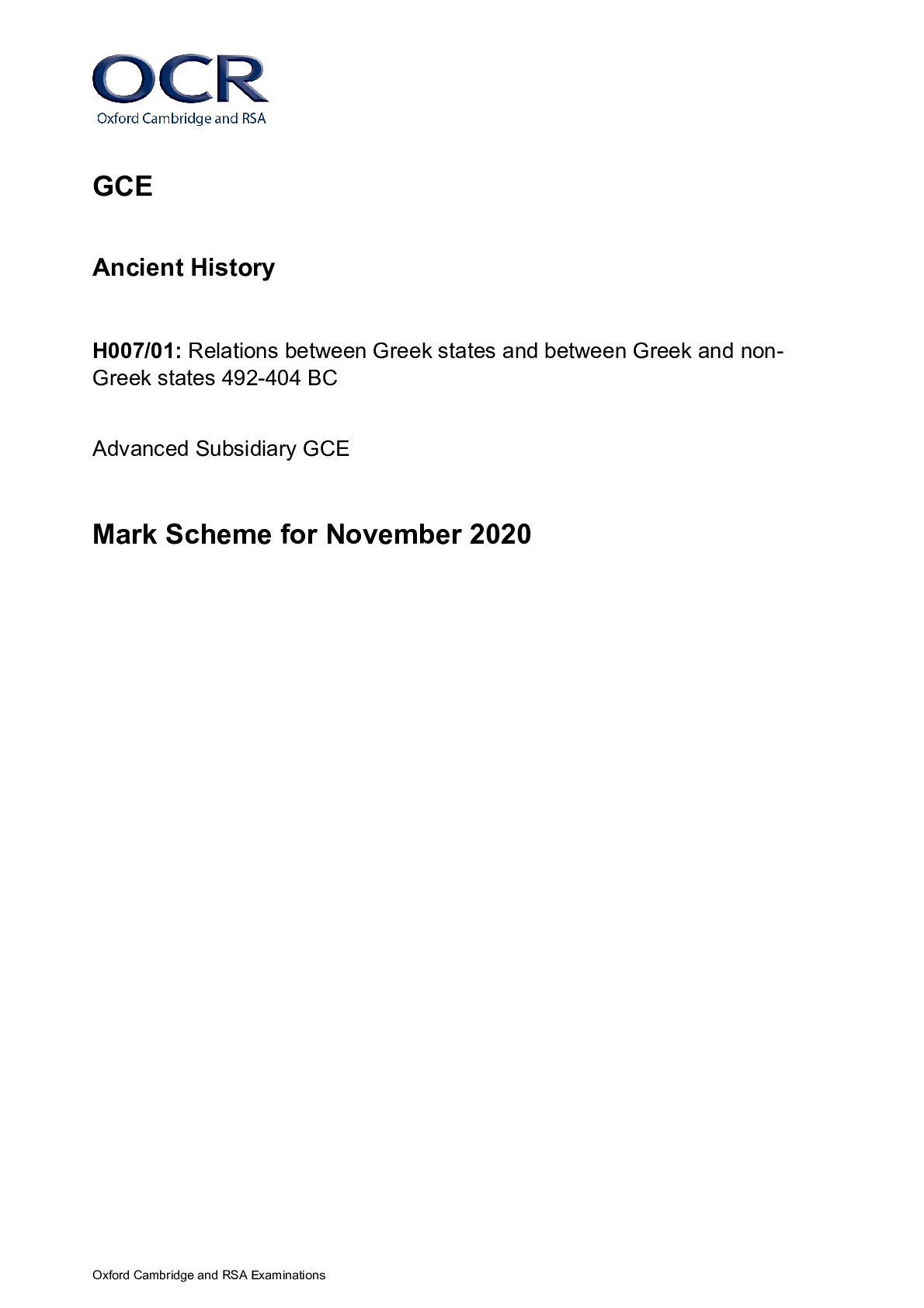
Buy this document to get the full access instantly
Instant Download Access after purchase
Add to cartInstant download
Reviews( 0 )
Document information
Connected school, study & course
About the document
Uploaded On
Oct 07, 2022
Number of pages
16
Written in
Additional information
This document has been written for:
Uploaded
Oct 07, 2022
Downloads
0
Views
38


